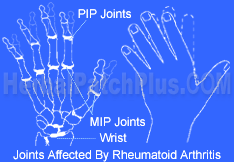|
Rheumatoid Arthritis Symptoms
|
|
|
|
Rheumatoid arthritis come and go very depends on the degree of tissue inflammation. When body tissues are inflamed, the disease is active.
When tissue inflammation subsides, the disease is remission (inactive). Remissions can occur spontaneously or with treatment, and can last
weeks, months, or years. During remissions, symptoms of the disease disappear, and patients generally feel well. When the disease
becomes relapse again (active), the rheumatoid arthritis symptoms can include fatigue, lack of appetite, low grade fever, muscle and joint
aches, and stiffness. Muscle pain and joint stiffness are usually most notable in the morning and after periods of inactivity. Arthritis is common
during disease flares, joints frequently become red, swollen, painful, and tender.
|
|
|
|
Multiple joints are usually inflamed in a symmetrical pattern (both sides of the body affected). The small joints of both the hands and wrists are
often involved. Simple tasks of daily living, such as turning door knobs and opening jars can become difficult during flares. The small joints of
the feet are also commonly involved. Occasionally, only one joint is inflamed. When only one joint is involved, the arthritis can mimic the joint
inflammation caused by other forms of arthritis such as GOUT or joint infection. Chronic inflammation can cause damage to body tissues,
cartilage and bone. This leads to a loss of cartilage and erosion and weakness of the bones as well as the muscles, resulting in joint
deformity, destruction, and loss of function. Rarely, rheumatoid arthritis can even affect the joint that is responsible for the tightening our vocal
cords to change the tone of our voice, it can cause hoarseness of voice.
|
|
|
|
Since rheumatoid arthritis is a systemic disease, its inflammation can affect organs and areas of the body other than the joints. Inflammation
of the glands of the eyes and mouth can cause dryness of these areas and is referred to as Sjogren's syndrome. Rheumatoid inflammation of
the lung lining causes chest pain with deep breathing or coughing. The lung tissue itself can also become inflamed and sometimes
rheumatoid nodules develop within the lungs. Inflammation around the heart can cause a chest pain that typically changes in intensity when
lying down or leaning forward. The rheumatoid disease can reduce the number of red blood cells and white blood cells. Decreased white cells
can be associated with an enlarged spleen and can increase the risk of infections. Firm lumps under the skin can occur around the elbows
and fingers where there is frequent pressure. Serious complication, usually long-standing rheumatoid disease can impair blood supply to
tissues and lead to tissue death. This is most often initially visible as tiny black areas around the nail beds or as leg ulcers.
|
|
|
|
|



